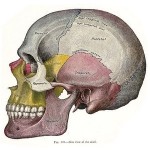 The temporomandibular joint (TMJ) can cause painful chewing, jaw clicking, ear/face pain, tooth pain, and headache. In the absence of an obviously locked jaw, the offending temporomandibular dysfunction (TMD) is usually diagnosed after the painful ears, teeth, and/or sinuses have been examined and found to be fine. While there are rare causes of TMD (inflammatory arthritis, tumor, infection) the vast majority of TMD results from an imbalance of the masticatory (chewing) muscles with or without localized swelling of the TMJ. Also, the muscle imbalance can cause problems with dental occlusion and vice versa. One can quickly see that a sufficient evaluation of head/face pain, even in the presence of a seemingly tell-tail clicking jaw, should be comprehensive.
The temporomandibular joint (TMJ) can cause painful chewing, jaw clicking, ear/face pain, tooth pain, and headache. In the absence of an obviously locked jaw, the offending temporomandibular dysfunction (TMD) is usually diagnosed after the painful ears, teeth, and/or sinuses have been examined and found to be fine. While there are rare causes of TMD (inflammatory arthritis, tumor, infection) the vast majority of TMD results from an imbalance of the masticatory (chewing) muscles with or without localized swelling of the TMJ. Also, the muscle imbalance can cause problems with dental occlusion and vice versa. One can quickly see that a sufficient evaluation of head/face pain, even in the presence of a seemingly tell-tail clicking jaw, should be comprehensive.
Since the majority of TMD is from functional muscle imbalance, it is unfortunate that muscular rehabilitation is often overlooked as a treatment strategy. Rehabilitation isn’t appropriate for every case of TMD. Yet in the absence of tumor, infection, inflammatory arthritis, and a causative occlusion problem, rehabilitation is the most appropriate management strategy.
Here’s the media from my professional lecture on Rehab of TMD.